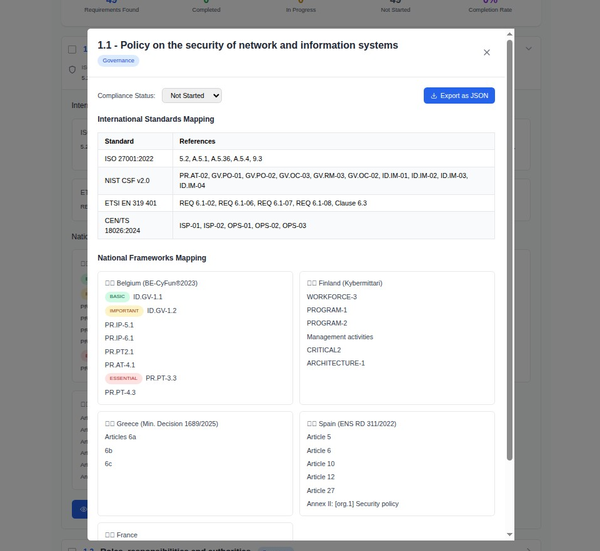Tutorial: Staying Ahead of Website Best Practices to Avoid Lawsuits

Introduction
In the rapidly evolving digital landscape, adhering to best practices for website management is crucial to avoid legal pitfalls. This tutorial outlines the steps businesses can take to ensure compliance with global privacy regulations and protect themselves from potential lawsuits.
Step 1: Understand Relevant Regulations
Key Regulations to Consider:
- GDPR (General Data Protection Regulation)
- CPRA (California Privacy Rights Act)
- CPA (Colorado Privacy Act)
- VCDPA (Virginia Consumer Data Protection Act)
- LGPD (Lei Geral de Proteção de Dados, Brazil)
Step 2: Implement a Robust Consent Management System
- Design Clear Consent Forms:
- Use plain language to explain data collection practices.
- Ensure forms are user-friendly and not buried in lengthy terms and conditions.
- Include options for users to give specific, informed consent for different data processing activities.
- Obtain Explicit Consent:
- Make sure users explicitly opt-in to data collection rather than using pre-ticked boxes.
- Provide an easy way for users to withdraw their consent at any time.
- Track and Manage Consent:
- Use tools to record and manage user consents.
- Regularly update consent records to reflect any changes in data processing practices.
Step 3: Enhance Data Subject Rights Management
- Create Transparent Privacy Policies:
- Clearly outline how user data is collected, processed, and stored.
- Update policies regularly to reflect any changes in data practices.
- Implement User Rights Management Systems:
- Develop processes for handling data access, correction, deletion, and portability requests.
- Set up automated systems to acknowledge and process these requests within the required timeframes.
- Educate Users:
- Provide clear instructions on how users can exercise their data rights.
- Offer multiple channels (email, online forms, support hotlines) for users to submit their requests.
Step 4: Conduct Regular Data Protection Impact Assessments (DPIA)
- Identify High-Risk Processing Activities:
- Regularly review data processing activities to identify those that pose a higher risk to user privacy.
- Perform DPIAs:
- Assess the potential impacts of high-risk activities on user privacy.
- Document the findings and implement measures to mitigate identified risks.
- Review DPIAs Regularly:
- Update DPIAs periodically and whenever significant changes to processing activities occur.
Step 5: Establish a Comprehensive Data Breach Response Plan
- Develop an Incident Response Plan:
- Outline procedures for detecting, reporting, and managing data breaches.
- Assign roles and responsibilities for breach response team members.
- Ensure Timely Reporting:
- Establish protocols to notify relevant authorities and affected individuals within the required timeframes.
- Prepare templates for breach notification to streamline the process.
- Conduct Regular Drills:
- Regularly simulate data breach scenarios to test and refine the response plan.
- Ensure all employees are aware of their roles in the event of a breach.

Step 6: Appoint a Data Protection Officer (DPO)
- Select a Qualified Individual:
- Choose a person with expertise in data protection laws and practices.
- Ensure the DPO has the authority and resources to perform their duties effectively.
- Define DPO Responsibilities:
- Oversee data protection strategy and implementation.
- Act as the point of contact for data protection authorities and users.
- Promote Continuous Training:
- Ensure the DPO and other relevant staff receive ongoing training on data protection developments and best practices.
Step 7: Implement Privacy by Design
- Integrate Privacy into Development Processes:
- Ensure privacy considerations are incorporated into the design and development of new products and services.
- Conduct privacy impact assessments during the planning and development phases.
- Adopt Data Minimization Practices:
- Collect only the data necessary for specific purposes.
- Anonymize or pseudonymize data where possible to enhance user privacy.
- Use Strong Security Measures:
- Implement encryption, access controls, and other security measures to protect user data.
- Regularly update and patch systems to address security vulnerabilities.
Step 8: Stay Informed and Adapt
- Monitor Regulatory Changes:
- Stay updated on changes in data protection laws and regulations.
- Subscribe to newsletters, attend webinars, and participate in industry forums.
- Engage with Legal Experts:
- Consult with legal experts to ensure ongoing compliance with data protection laws.
- Conduct periodic compliance audits to identify and address potential issues.
- Promote a Culture of Privacy:
- Educate employees about the importance of data privacy and security.
- Encourage a proactive approach to identifying and mitigating privacy risks.
Conclusion
By following these best practices, businesses can not only avoid potential lawsuits but also build trust with their users through robust data protection measures. Staying ahead of regulations and adopting a privacy-first approach will ensure long-term compliance and safeguard against legal and reputational risks.
Understanding Global Privacy Regulations and Their Impact on Ad Platforms
Introduction
In today's digital landscape, user data privacy is paramount, especially for platforms like Google AdSense that handle vast amounts of personal data across different regions. With various global regulations in place, platforms must navigate a complex web of legal requirements to ensure compliance and protect user privacy. This article delves into key privacy regulations impacting ad platforms, focusing on GDPR, US state regulations (CPRA, CPA, VCDPA), and Brazil's LGPD, and offers insights into managing compliance.

European Regulations: GDPR and EPD
The General Data Protection Regulation (GDPR) is a comprehensive data protection law in the EU, impacting how companies collect, store, and process personal data of EU citizens. It emphasizes user consent, data minimization, and the right to access and delete personal data. Key aspects include:
- Consent Management: Companies must obtain explicit consent from users before collecting their data. This includes cookies and tracking technologies.
- Data Subject Rights: Users have the right to access, correct, and delete their personal data. Platforms must provide mechanisms for these requests.
- Data Protection Impact Assessments (DPIA): Required for high-risk data processing activities to identify and mitigate privacy risks.
- Breach Notification: Data breaches must be reported to authorities within 72 hours.
The EPD (E-Privacy Directive) complements GDPR, focusing on electronic communications and online tracking, such as cookies and email marketing.

US State Regulations: CPRA, CPA, VCDPA
In the US, data privacy regulations are more fragmented, with individual states enacting their own laws. The most notable are:
- California Privacy Rights Act (CPRA): Enhances the CCPA by adding new rights and obligations, including:
- Right to Correct: Users can request corrections to their data.
- Sensitive Data Handling: Stricter regulations on the use of sensitive personal data.
- Automated Decision-Making: Transparency and opt-out rights for automated decision-making processes.
- Colorado Privacy Act (CPA): Similar to CPRA, it includes:
- Data Controller Obligations: Clear responsibilities for data controllers regarding data processing and user rights.
- Opt-Out Rights: Users can opt out of data sales and targeted advertising.
- Virginia Consumer Data Protection Act (VCDPA): Focuses on data minimization and user rights, such as:
- Data Protection Assessments: Required for processing activities posing a heightened risk to consumers.
- Rights to Access and Delete: Similar to GDPR, ensuring users can manage their data.

Brazil's LGPD
The Lei Geral de Proteção de Dados (LGPD) is Brazil's comprehensive data protection law, aligning closely with GDPR principles. It covers:
- User Consent: Similar to GDPR, requiring clear and affirmative consent for data processing.
- Data Protection Officer (DPO): Mandatory appointment of a DPO to oversee compliance.
- Data Breach Notification: Obligatory reporting of data breaches to the national authority and affected individuals.
- Rights of Data Subjects: Including access, correction, deletion, and portability of personal data.

Best Practices for Compliance
- Implement Robust Consent Management: Use clear and transparent consent forms that comply with GDPR, CPRA, CPA, VCDPA, and LGPD requirements. Ensure users can easily withdraw consent.
- Enhance Data Subject Rights Management: Develop efficient processes to handle requests for data access, correction, deletion, and portability.
- Conduct Regular Data Protection Impact Assessments (DPIA): Especially for high-risk processing activities, to identify and mitigate privacy risks.
- Establish a Comprehensive Data Breach Response Plan: Ensure timely reporting and communication with authorities and affected individuals.
- Appoint a Data Protection Officer (DPO): To oversee compliance and act as a point of contact for data protection authorities.
Conclusion
Navigating global privacy regulations requires a thorough understanding of the legal landscape and proactive compliance strategies. Platforms like Google AdSense must implement robust privacy measures to protect user data and adhere to regulations such as GDPR, CPRA, CPA, VCDPA, and LGPD. By focusing on consent management, user rights, and data protection assessments, companies can foster trust and ensure compliance in a dynamic regulatory environment.






